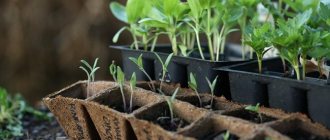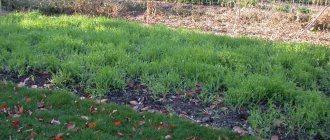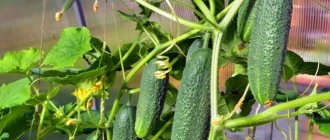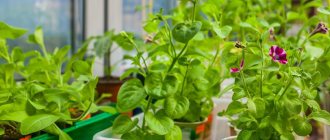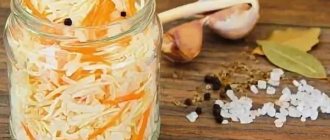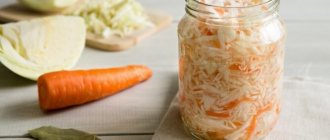Watermelon is a melon crop that can be grown in any region of the country. Watermelon seedlings are a task that not every knowledgeable gardener can handle. If you know the rules for growing and caring for the fruit, then there will be no special problems with growing it.
When you know all the intricacies of planting: the choice of soil, the date of planting the fruit, weather conditions, you will grow a good harvest without much effort.
Advantages of the seedling method
The emphasis of this method is that when planting seedlings in this way, they will be stronger. The seedling method allows you to grow young seedlings at home, and then transplant them into a place that you have prepared for growing melons.
Seedlings grown using the seedling method have early ripening, they have more stable immunity and thus can resist diseases and viruses
Site preparation and fertilization
On soils with low humus content, the following in the fall :
- compost – 5–6 kg/sq.m.;
- dolomite flour – 30 g/m2.
In spring , the soil is enriched with minerals:
- superphosphate – 35 g/m2;
- potassium sulfate – 15–20 g/m2.
It is strictly forbidden to apply fresh manure under watermelon, as this provokes fungal diseases, reduces the taste of the fruit, and increases the nitrate content. When cultivating melons and melons, it makes sense to use green manure, for example, peas, mustard, etc.
Favorable days for planting watermelons in 2022
To determine the watermelon planting date in 2022, you need to consider some factors:
- region;
- melon variety;
- weather.
When to plant watermelon seedlings in 2022? Sowing of the crop must be done in March and April.
Most accurate dates:
- March 4, 5, 6, 7, 10, 30, 31 - these days are best to plant greenhouse varieties.
- April 1, 2, 8, 19, 27 – on these dates you can plant varieties that grow well in open ground.
- In May, until the 11th, you can plant all the seedlings in open ground.
- In June, you can plant completely different varieties of watermelons.
Unfavorable days for planting melons and melons in 2022
- April from 9 to 11, as well as April 23, 24.
- In May, it is better not to plant on the 12th, 13th, 20th and 21st.
- There are quite a lot of unfavorable days in June - 3, 4, 5, 8, 9, 16, 17, 30.
The optimal age of watermelon seedlings for planting in the ground is 25-35 days.
Now you know when to plant watermelon seedlings.
Seed germination - timing and testing
High-quality planting material is the key to a good harvest. An indicator of the quality of watermelon seeds is their germination rate. In most cases, when preparing for the next season, gardeners audit the seed material of various crops, discovering that some of them are already more than one year old. What to do in this case, throw it away and buy new ones, or can it still be used for planting? It is enough to know that the germination of watermelon seeds lasts for 6–8 years.
In addition, there is a way to test watermelon seeds for germination, which is also suitable for other melons. To do this, you will need sawdust, which is first doused with boiling water several times (every half an hour). You will need to prepare a container, for example, a tray or small box, which is filled with raw sawdust. The seeds are laid out in rows with a distance of 2–3 cm. A gap of 1–1.5 cm is made between the seeds. Then the seed is sprinkled with sawdust and compacted, and the container is placed in a warm place with a temperature of +23–27˚С and wait for the sprouts to appear. To determine the percentage of germination, a simple calculation is performed: if 6 out of 10 seeds germinate, it means the germination rate is 60%.
The best varieties for forcing seedlings
The choice of varieties must be approached with great responsibility. It is important to understand which variety is suitable for your region of residence. When purchasing varieties, pay attention to the timing of early ripening, resistance and disease tolerance, and other indicators.
In this article we will talk about those varieties that can be planted in central Russia.
- "Crimson Sweet." A fairly common type of berry. The ripening period of this species reaches up to 80 days after planting in the ground. This variety can bear fruit even in drought. Planting of the crop occurs in May, and harvesting occurs at the end of August and beginning of September. The berry peel itself is smooth, has shades of green, and is usually oblong in shape. The weight of the melon crop can vary from 5 to 12 kilograms if it grows in favorable conditions. The pulp of the berry itself is dense. When you cut a watermelon, its sides burst, which indicates its ripeness. taste honey, sweet.
- "Spark." The ripening period of this fruit reaches from 75 to 87 days. It is recommended to plant in open ground when there is no threat of frost. The berry has a spherical shape and barely noticeable green stripes. The weight of the fetus is on average 2 kilograms. The pulp is orange in color, grainy, and juicy in taste.
- "Siberian Lights" The fruits of this berry have a round shape. This crop is grown in open ground and greenhouses on light soil. This variety is sown in open ground at the end of May. Seedlings can be planted at the end of April, beginning of May. At the age of 30 - 35 days, they can be planted in open ground, when frosts no longer occur. The weight of the berry reaches 5 kilograms. Juicy, aromatic taste. With good care, you will get an excellent harvest.
- "Ultra-early". This species differs from other species in that it is quite unpretentious and resistant to weather conditions. From sowing to harvest, development takes about 80 days. It has one more difference from other varieties: it is a fairly compact plant with a small number of side shoots. The fruit is round in shape with dark green stripes. The weight of the fetus reaches up to 5 kilograms. The middle of the berry is juicy and tender.
- "Peasant". The fruit is planted in May. The ripening period of melons is about 10 days. It has an oval shape with a smooth surface and thick bark. The pulp is quite dense, granular – sugary and sweet. The weight of the berries varies from 5 to 8 kilograms.
- "Emperor's Hat" The ripening period for melons is from 95 to 100 days for open ground. The advantages of this product: transportable, disease-resistant, can be stored for quite a long time. It has a juicy taste. The pulp is grainy. The weight of the fetus reaches 10 kilograms. This variety has an oval shape with black stripes.
Subsequent care of seedlings
Due to the fact that sowing is done in mid-spring, additional lighting of the plants is not required in this case. But the crops still need to be placed in the brightest place in your home. The ideal option is the window sill of a south window. It will be even better if you transfer the seedlings to a glassed-in loggia (but in this case you need to especially carefully monitor the temperature conditions).
Watermelon seedlings on the windowsill
What should the temperature be when growing seedlings? At first, even before the first shoots form, the temperature should be within +25-27°C. Later, when the shoots have already appeared, it should be somewhere around +18-20°C (at night) and +20-25°C (during the day). As for watering crops, it is recommended to use exclusively warm water.
10 days after the first shoots appear, fertilizing should be done in the form of a solution of mineral seedling fertilizer (such as Sotka, Mortar, etc.). After the same time, fertilizing is repeated.
Fertilizer "Solution"
Note! Watering and fertilizing should be done exclusively at the root! If moisture does get on the leaves, immediately wipe everything off using a paper napkin. When at least 4 true leaves appear, the seedlings - if weather conditions allow - can be transplanted to the site.
It should also be noted that when growing seedlings of this crop, the pots should be placed in such a way that the leaves of neighboring plants do not touch each other.
The leaves of the seedlings should not touch
Prices for Mortar
Mortar
Seed selection
This stage of preparation must be approached with all responsibility, since the further outcome of all your work and efforts depends on it. A wide range of products allows you to choose exactly those varieties that are best suited to your climate.
What differences between watermelons can be:
- Variety;
- Immunity;
- Rate of ripening;
- Resistance to various diseases.
It is recommended to choose hybrid seeds for planting, as they are the most resistant to weather conditions and unfavorable factors that may be present in the external environment
Pre-sowing seed preparation
Before buying varieties, you need to pay attention to the packaging and study it carefully. In central Russia, the melon crop must have time to ripen before the onset of autumn cold weather. The bag of seeds must indicate in how many days the crop will sprout.
If 80 - 90 days, feel free to buy this variety, as they will sprout without unexpected surprises.
You should also pay attention to the expiration date of the seeds; it is better to buy fresh seeds that were prepared no more than three years ago.
Brief description of the plant
Watermelon is a member of the pumpkin family. This is an annual creeping plant with a highly developed root system, but shallow (up to 60 cm deep into the soil). Watermelons produce long vines, usually up to 2 m. The shoots have dark green leaves on rather long petioles. Tendrils and single flowers grow from the axils of the leaves. Clinging tendrils, when supported, allow plants to grow vertically in a limited area.
Watermelon – has male and female flowers that are pollinated by insects. Pollinator studies were carried out, and it turned out that bumblebees are the best pollinators of flowers. Then the set fruit will have many more seeds. Bumblebees are more likely to visit flowers than bees. The flowers are small and disappear within a day.
The fruit of watermelon is a pseudoberry, the shape of which varies from round to oval and elliptical. Edible pulp inside the fruit. Its color can be red, pink, yellow.
In nature, watermelon grows in Central and Northern Africa, growing better in regions with warm, hot climates. Just 50 years ago, no one thought about growing watermelons in the middle zone. However, for several years now there have been varieties suitable for amateur cultivation on sale.
More and more summer residents are trying to grow this juicy fruit. However, in many regions of Russia, with the exception of the southern ones, this is not an easy task, since watermelon is native to South Africa and requires a lot of sun to grow. However, there are several varieties of watermelon adapted to our climate. With luck, good weather and proper care, you can reap a good harvest, so it's worth experimenting. Below are a few tips to keep in mind if we decide to grow watermelon.
Calibration
The germination of seeds and the further development of young plants depend on this procedure. This issue must be approached with full responsibility. It is necessary to select the strongest and most viable seeds.
How to do it? Create a saline solution: pour 1 liter of water and add 50 grams of salt to a glass of water. Mix everything well. Empty and smaller seeds will float to the surface, while the best ones will remain at the bottom of the glass. These are the ones we need.
Selected seeds can simply be dried. Stronger seedlings develop better, thereby destroying poorer and smaller seedlings. When you size the seeds, they grow more uniformly and abundantly.
There is another option for sizing seeds: simply scatter all available seeds on the surface and manually select large and powerful seeds. Everything is simple here: large seeds have more nutrients, which will further affect the growth and harvest of your crop.
Warming up and soaking
It is important to understand how this stage is useful.
When you heat and soak the seeds, the speed of biochemical reactions in the cells increases sharply, which leads to a rapid increase in seed germination. Female flowers also develop much faster thanks to this procedure. Step by step steps:
- The seeds must be soaked in water for several hours. You can place them in some special bag. The water should be 50 -60 degrees, no more and no less.
- Next, you should place this bag in potassium permanganate for 25 - 30 minutes. This point will help kill all the “infection” of your crop.
- After soaking in the solution, remove the bag from the water and let all the liquid drain. All seeds are removed and placed on paper or a sandy surface to dry. Leave for about several days (two or three) until sprouts appear. Be sure to leave the seeds in a warm room. Make sure the temperature is room temperature.
Sprouted watermelon seeds
If you purchased seeds in a store, you do not need to go through all these stages of work, but can immediately plant them in the ground.
In order for your plants to be adamant to temperature changes, stable and unshakable, it is necessary to carry out the hardening stage. It is also useful because after hardening, the harvest will be more abundant and larger.
Temperature
After sowing the seeds, the containers are placed in a warm, well-lit place. Before germination, the temperature in the room should be at +22…+25°C. Temperature maximum – +30°С.
When ventilating, the temperature regime cannot be changed: the seedlings are left open for 10-15 minutes away from drafts.
After germination, the containers are moved to cooler conditions and kept for 3 days at a temperature of +15...+19°C. When the seedlings get stronger, the cups are moved to the south window and the temperature is adjusted: +20...+21°C during the day and 18-19°C at night.
Hardening
This method can usually be used in different ways. Everyone chooses the necessary option for themselves.
1 hardening option. Temperature drop. The swollen seeds can be placed in the refrigerator or room where the temperature is not higher than 0 degrees. Place for several hours, stirring occasionally. If you do all this in the spring, then you can immerse the seeds in the snow for several hours.
Don’t forget to put them in some kind of bag before immersing the seeds in the snow.
Hardening option 2. Variable temperature. Swollen seeds can also be placed either in the refrigerator or in a room where the temperature is below 6 degrees. The need for exposure in this room is about 6 hours. Next, you should leave this bag of seeds in a room where the air temperature reaches 18 - 20 degrees. The time period is 6 hours. It is necessary to repeat the procedure several times (preferably 3 times).
Before sowing, it is advisable to dry the seeds a little
Thus, it becomes clear that planting watermelon seeds for seedlings takes more than one day. The process is quite labor-intensive.
Selecting a landing container
For subsequent transplantation of sprouts into the ground or greenhouse, you need to be careful and remember that when choosing a container, you can damage the roots when you remove the sprout from the container. Many people simply use plastic pots. Many people also choose peat and paper cups.
The advantage of cups is that you don’t have to pull out the plant before planting it in the ground. The roots of the plant will very easily and quickly cope with this obstacle and establish themselves in the way they need in the ground.
It is important to know that the depth of the cups should not be more than 10 centimeters
What to do if watermelon seeds have not sprouted
Sometimes gardeners are faced with such an unpleasant situation when the watermelon seeds do not germinate. What could be the reason and how to correct the situation? One of the main problems can be low quality seeds. If seed material is purchased in a store, be sure to check the expiration date on the packaging. In addition, you can focus on price, but it is not always an indicator of quality: both cheap and expensive seeds can have good germination.
When purchasing watermelon seeds, you should pay attention to the date of manufacture, and when storing your planting material for a long time, check it for germination
If you still have watermelon seeds from previous years without packaging or you collected planting material yourself, you need to identify the seeds that are unsuitable for sowing. To do this, pour the grains into a container with water and those that end up on the surface do not make sense to plant.
Many factors influence seed germination:
- degree of maturation;
- collection and drying conditions;
- storage conditions;
- date of packaging.
The listed factors usually depend on the seed manufacturer. However, the success of the entire event directly depends on the conditions that will be created for their germination. This suggests that if the seeds are obviously of good quality, but the humidity or temperature does not meet the required parameters, then the material may simply not germinate. In addition, when planting sprouted seeds in open ground with cold soil, they may slow down in growth or even die.
Traditional cultivation of watermelon seedlings
There are no particular difficulties in growing. Let's take a closer look.
- It is necessary to properly prepare the soil for growing. Here you can make the proportions 0.5 parts humus, 1 part sawdust and 1 part turf soil. Everything needs to be mixed thoroughly and well.
- Capacity. Choose separate pots so that the roots of the plants are not damaged when transplanting into the ground. The best option for pots is 10 cm.
- Proceed directly to landing. First, fill the already prepared soil halfway, then plant the seeds 4 - 5 centimeters deep (1 or 2 is possible). Next, cover with the remaining soil. Important! Don't forget to moisten the soil before sowing. In the future, make holes with any stick or you can use a simple pencil.
The pot must be covered with regular cling film and left for 35 - 40 days. Should be kept indoors at room temperature
Using peat pots
You can also grow seedlings in peat pots. What are these pots good for? They contain all the necessary nutrients that are needed directly for sprouting.
The principle of operation is similar to the previous one. Let's take a closer look below.
- It is necessary to properly prepare the soil for growing. Here you can make the proportions 0.5 parts humus, 1 part sawdust and 1 part turf soil. Everything needs to be mixed thoroughly and well.
- Next, you need to prepare and germinate the seeds (everything is unchanged here, you can see how this is done a little higher). When the root reaches 1 - 1.5 centimeters, you can proceed to sowing.
- Prepare pots with a diameter of at least 10 centimeters and fill them with ¾ of the mixture (how it is made is described a little higher). Next, place the already germinated seeds in the pots.
- After planting, it is necessary to sprinkle the crops with the mixture and compact them a little with your hands so that they do not become bare when watering. Otherwise, there may be no harvest at all.
- Water the crops carefully. Advice. You can place peat pots in containers that are the right size. This way the walls of the pots will not dry out very quickly.
Problems with seedlings and solutions - table
| Problem | Cause | Solution |
| Seeds cannot shed their shells | The seeds are sown finely or the seed is weak, underdeveloped | Moisten the shell with water several times a day; the watermelon will shed it on its own. Do not pull the dry shell with your hands; the seedling may die. |
| Uneven shoots | The seeds were sown at different depths, covered with heavy soil on top, and a crust formed. | Use loose soil for watermelon seedlings and sow the seeds at the same depth. |
| The seedlings died, the stems darkened close to the ground | The seedlings got sick with black leg. Among the reasons: excessive watering, contaminated soil, cold windowsill. | Stop watering until the top layer of soil dries. If watermelons are grown in one common box, then remove the diseased shoots with a piece of soil, water the remaining ones with potassium permanganate. Follow the rules for watering watermelons! |
| The seedlings stretched out | Not enough light or nutrients | Pour or spray with Atlet solution (1.5 ml per 1 liter of water). The stems will become thicker, the leaves will be larger, and the roots will develop better. On cloudy days, illuminate the seedlings with lamps. Every day, turn the seedlings to the sun with the other side. Remove other plants and objects from the windowsills that may shade the seedlings. |
| Pests have appeared | Aphids or spider mites can move onto watermelons from indoor flowers or from the soil in which they overwinter. | Do not keep indoor flowers on the same window, or better yet, in the same room with seedlings. Steam the soil before planting. Spray with biological products: Fitoverm (2 ml per 1 liter of water) or Agravertin (5 ml per 0.5 liter of water). Repeat after 7–10 days. |
| Leaves turn yellow | Not enough power | Feed with Agricola, Fertika Lux or Uniflor. |
| Colorless (white) spots on leaves | Seedlings that are taken out of the room into bright sun for the first time often get sunburn. | Start hardening on a cloudy day or shade the watermelons, for example, with paper. On the windowsill, the leaves of the seedlings should not touch the glass. |
| White mold on the soil surface | There are mold spores in the air of any room. It develops in waterlogged soil with a lack of ultraviolet rays. | Loosen, sprinkle the ground with crushed coal, wood ash, spray with a weak solution of brilliant green (1 drop per 1 liter of water). |
Growing stages
We are moving on to the next stage of growing melons. There are several stages here. Let's look at each in more detail.
Planting seeds in open ground
The most optimal time for planting seeds is when the air temperature reaches 14 - 15 degrees, and the mail is warmed 10 centimeters deep. In this matter, you need to be sure that there will be no frosts, therefore, you can start sowing the crop at the end of May.
To plant melons, you need to prepare holes, which must be 1 meter in diameter, the depth of the hole must be at least 30 centimeters . What should be in the hole:
- Humus - 1 kilogram.
- Ash 1 tablespoon.
- Nitroammophosphate 1 teaspoon.
Next, the hole should receive approximately a couple of liters of water. After soaking, plant 4 or 5 seeds in the hole at a depth of 5 - 7 centimeters. Next, cover everything with soil and compact it well so that the roots are not exposed.
After planting the seeds, do not water the garden bed.
Next, you need to water the beds abundantly when you notice that the soil begins to dry out. Carry out the procedure at least once a week.
When the first shoots appear, you need to thin out so that as a result there are 1 or 2 plants left in the hole.
Caring for watermelon after planting
Everyone understands that after planting the seeds, one should not forget and think that the watermelon will then grow by itself. It is also necessary to monitor the melon crop, water, thin out, weed and carry out other manipulations if you want to have a good, large, sweet fruit.
It is necessary to feed the seedlings every two weeks. But after planting you need to feed it after the first week. How to prepare watermelon fertilizer: 15 grams of superphosphate, 10 grams of ammonium nitrate and 11 liters of water. Before fertilizing, the soil must be moistened and only then fertilized. After the procedure, it is also necessary to clean the soil by dousing it with water.
Watermelons love water very much and they need to be watered with special cravings during the formation of leaves and stems. And when the fruit begins to ripen, you need to reduce the number of waterings so that the fruit gains sugar content
Watering a watermelon
Watermelons love water very much. They need to be watered fairly generously once a week. During periods of extreme drought, it is necessary to water not only the roots and holes, but also the spaces between the rows. Simply put, you can water the entire garden bed. In the future, watering can be reduced.
It is necessary to completely eliminate water two weeks before harvesting so that the fruit gains sugar content. After planting a couple of days, it is necessary to loosen the soil by 6 centimeters and remove the weeds.
When the watermelons have already closed rows, there will be no need to weed them because the weeds will not cause harm
Feeding watermelon
After the seeds are planted, you need to wait about two weeks and only then can you start feeding them. You need to add 20 grams of ammonium nitrate to a bucket of water.
Next, water each hole with 2 liters. The next stage of feeding will be during the period when budding begins. Here the composition will be slightly different. 4 grams of calcium chloride, 4 grams of ammonium nitrate and 6 grams of superphosphate - per plant.
Here you can choose to use fertilizer. Either dry or mixed with water. If you feed dry, water the crop generously after feeding.
When to plant watermelons in a permanent place?
The main rule for a gardener is to plant seedlings in the evening or on a cloudy day. Watermelons should be well watered 3-5 hours before. Of course, there should no longer be frost in the morning. A temperature favorable for watermelons is required: during the day +20... +30 ⁰C, at night not lower than +16... +18 ⁰C. The seedlings are shaded for the first 2–3 days.
Video: What should seedlings look like when planting, plus how important it is not to damage the watermelon root
Watermelon is a capricious crop. It is worth studying its features before you start growing seedlings. So, the roots are very sensitive to transplantation, and water and nutrition are taken from the depths. The above-ground green part needs a lot of light and warmth. But you can’t expose the seedlings too harshly to the sun. To get a good harvest of watermelons, you need to try not only when growing in a permanent place, but also at the seedling stage.
- Author: Marina Volkova
I live in Siberia. I have my own house and my own plot) In the articles I share my experience, I learn something myself together with you) Rate the article:
- 5
- 4
- 3
- 2
- 1
(12 votes, average: 4.8 out of 5)
Share with your friends!
Growing watermelon in a greenhouse
How to grow seedlings was described earlier, now it’s time to transplant the watermelon into the greenhouse. Before planting, it is necessary to prepare the greenhouse. To do this you need:
- Clean the soil, or better yet, remove it. Typically, a thickness of about 20 centimeters is removed. In its place it is necessary to lay a thick layer of straw or humus; you can put it all together - this will even have a better effect on the harvest. Sprinkle nitrate fertilizers on top. To ensure that the fertilizer dissolves and the straw becomes moist, water the entire area well. Fill the removed soil on top and cover with a dark blanket (ordinary dark film will do). Planting work on this soil can be carried out within a week.
- Next you need to do some digging. When you dig, fertilize the soil with humus if planting is planned in the near future. If you plan to plant in a few months, you can simply fertilize with manure.
- Make beds, the height of which should be at least 30 centimeters. Fill the mixture with river sand and garden soil (10 kilograms per 1 square meter), adding mineral fertilizers to it.
Watermelon roots grow better in soil with a pH level between 6 and 7. The temperature before planting should be at least 12 degrees.
As the fruits begin to grow and enlarge, be sure to turn them over so they ripen evenly. Remember to ventilate the room
Watermelon transplant
Watermelon can be transplanted either into open soil or into peat pots.
Transplanting watermelon into open soil
Before transplanting, the first thing to do is check the soil to see if it has warmed up enough. The optimal temperature for watermelons is considered to be 15 – 18 degrees. Only then proceed to this operation.
The area that you have chosen for seedlings must be dug up to the bayonet of the shovel, since the watermelon roots deep enough inside
It is also necessary to apply fertilizer to every square meter of area. What is included in the fertilizer: 10 liters of humus or compost, 200 grams of wood ash and 20 - 40 grams of mineral fertilizer. After fertilizing the soil, repeat the procedure of digging the soil.
Transplanting seedlings in peat pots
First make holes. Leave some distance. Make approximately 2 holes per 1 square meter. Then remove the top of the pot and carefully place it in the hole. You need to water the hole and fill it with soil. Until constant warmth sets in, cover the soil with some kind of insulating material. Afterwards, you can remove the material.
Watering
Watermelons like moderate humidity. It is recommended to water them rarely, but abundantly. Constant moisture stagnation should not be allowed. The indicator is the drying out of the top layer of soil by 1-2 cm.
To check the soil moisture, you need to take some soil and roll it into a ball. If the soil is dry, it will crumble in your hands.
When watering watermelon seedlings, do not allow water to get on the leaves. At the same time, be sure to monitor the total air humidity. Melons do not like drought.
After each watering, the soil is loosened. The next portion of water is applied only on loose soil. For irrigation, use settled water at room temperature.
Seedlings in peat cups and tablets need to be watered more often than in ordinary plastic or wooden containers.
Pests and diseases of watermelon
Powdery mildew. It is most often caused by a fungus. How to determine. The leaves begin to become more grayish with a white tint, as if plaque, and accordingly they begin to die, which leads to a tasteless fruit.
If the fungus is not detected in time, this can lead to deformation of the fruit and death altogether.
Perenosporosis. Also, the pest is quite strong. It's the same fungus. The difference is that the infection occurs first on old leaves, only then does the fungus spread to young leaves. The color of the fungus is also different: the top of the leaf is covered with yellow spots, and the bottom is visible with a light purple coating.
If the fungus is not immediately recognized, it can lead to the cessation of fetal development.
Olive spot. Here the stems bear the brunt of the disease. The leaves also become covered with spots, ulcers form on the stems, as a result of which the ovaries dry out and fall off.
Medyanka. Infection from the fungal family. As a result of infection of the fruit, the leaves acquire yellow spots with pink pads. If the infestation is severe enough, the watermelon dries out and dies.
Melon aphid. This is dangerous enough in itself. It feeds on the juice of parts of the watermelon, which leads to the death of the fetus. You will not save your fetus, since there are no vaccines against it.
Gnawing owls. Egg deposition occurs on the leaves of the fruit. Next, larvae emerge from the eggs and begin to feed on the watermelon itself and its leaves. The fruit dries and dies
How to grow a square watermelon
Square or cubic watermelons have only one advantage - they are easier to store and transport. To grow such watermelons you will need cubic plastic containers with a diagonal larger than the expected diameter of the watermelon and many ventilation holes.
Watermelons that have grown to the size of an apple are placed in such containers. Care for the fruits as usual, adjusting the frequency and amount of watering as necessary.
Reference. To reuse containers, they must be collapsible and have a hole 3-4 cm in diameter in one of the faces for escape with the fruit.
Collection and storage of watermelons
You can start harvesting melons at the first stage of harvest maturity. Typically, this stage occurs five days before the fruit is fully ripe. If you harvest ahead of schedule, then the likelihood that the product is not ripe is high enough. And if you harvested the crop after the watermelon has ripened, then the likelihood that it will not last long also remains high.
When the harvest occurs on time, the flesh of the watermelon is pink in color and while the fruit lies, it ripens and the color of the pulp becomes redder.
In order for the product to be stored longer, it is necessary that the rind of the fruit is smooth and does not have any defects in the form of scratches, cracks, etc. How to store melons:
- Collect moss in the forest and find a box. Cover each watermelon with moss and place in a box. Remember that there can be several watermelons in a box, but they all must be protected with moss.
- You need to find a dark and cool place in the apartment. Place your harvest there. Turn it over every day.
- If you have a cellar, sprinkle straw on the racks and place watermelons on it. Also cover each watermelon with straw.
Neighbors and predecessors
To guarantee a good harvest of melons and melons, you need not only to follow the planting rules, but also to know about the compatibility of plants with each other:
- Watermelon does not tolerate gusty winds well. To create shelter, corn, peas or beans are planted around the area;
- all members of the pumpkin family, including watermelon, are compatible with black radish plantings. This plant secretes phytoncides that prevent the appearance of spider mites;
- an excellent neighbor of watermelon is melon;
- it is well compatible with potatoes and oat root;
- corn and peas improve the growth and taste of watermelons;
- sow thistle and pigweed promote the growth of melon plants;
- watermelon grows well next to greenery plantings (parsley is an exception);
- Tomato phytoncides drive away aphids, sawflies and moths.
All representatives of melons grow very strongly, so it is better to plant crops next to them that give an early harvest.
Planting some plants next to a watermelon negatively affects its growth and productivity, so you need to approach the choice of neighbors responsibly:
- melons grow well in open, sunny areas, so they are not planted next to trees and shrubs that shade the area;
- watermelon does not like the proximity of strawberries and representatives of nightshades (potatoes, tomatoes, eggplant, peppers);
- it extracts a large amount of minerals from the soil, so growing watermelon next to beets, carrots, garlic and radishes is not recommended;
- Watermelons should not be planted together with related plants - pumpkins or zucchini, as well as cucumbers.
An important agrotechnical technique is crop rotation. When alternating melons and melons at intervals of 3–4 years, the number of pests and diseases, as well as weeds, is significantly reduced in the field. It is not recommended to grow watermelon in one field for more than 2 years in a row; the optimal predecessors for it are:
- winter wheat,
- perennial herbs,
- corn for green fodder,
- radish,
- dill,
- basil,
- tomatoes,
- celery,
- roots,
- onion,
- cabbage.
It is strictly not recommended to plant melons in an area where melons, squash or zucchini previously grew. After harvesting the watermelon fruits, it is better to plant this area with legumes (green beans, peas) or garlic.



